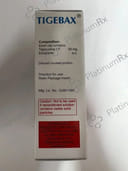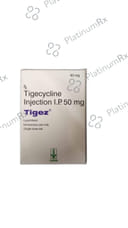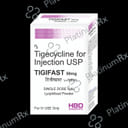Tigecycline
Uses
Tigecycline is used for the treatment of severe bacterial infections.
How it Works
How Tigecycline works Tigecycline is an antibiotic that inhibits bacterial growth by preventing the synthesis of essential proteins necessary for bacteria to perform vital functions.
Side Effects
Common side effects of Tigecycline include headache, vomiting, nausea, increased liver enzymes, stomach pain, and diarrhea.
Expert Advice
- Tigecycline is an antibiotic typically administered in a hospital setting for serious infections.
- Do not skip any doses and complete the full course of treatment, even if you start to feel better.
- Stopping the medication early may cause the infection to return and become more difficult to treat.
- Tigecycline may cause dizziness; avoid driving or engaging in activities that require mental focus until you understand how it affects you.
- Diarrhea may occur as a side effect but should resolve once your treatment course is complete.
- Inform your doctor if diarrhea persists or if you notice blood in your stools.
- Notify your doctor if you are pregnant, planning to conceive, or breastfeeding.
- Discontinue Tigecycline and contact your doctor immediately if you experience a rash, itchy skin, swelling of the face and mouth, or difficulty breathing.
Other Combinations
Related Medications
Tigecycline 50mg

₹1,735.7

₹1,931.3
MRP ₹2,759.1
Tigecycline 50mg

₹5,635

₹1,931.3
MRP ₹2,759.1
Tigecycline 50mg

₹3,033

₹1,931.3
MRP ₹2,759.1
Tigecycline 50mg

₹3,500

₹1,931.3
MRP ₹2,759.1
Tigecycline 50mg

₹2,800

₹1,931.3
MRP ₹2,759.1
Tigecycline 50mg

₹5,635

₹1,931.3
MRP ₹2,759.1
Tigecycline 50mg

₹3,000

₹1,931.3
MRP ₹2,759.1
Tigecycline 50mg

₹4,290

₹1,931.3
MRP ₹2,759.1
Tigecycline 50mg

₹3,200

₹1,931.3
MRP ₹2,759.1
Tigecycline 50mg

₹2,918

₹1,931.3
MRP ₹2,759.1
Tigecycline 50mg

₹3,128.6

₹1,931.3
MRP ₹2,759.1
Tigecycline 50mg

₹3,500

₹1,931.3
MRP ₹2,759.1
Tigecycline 50mg

₹3,080

₹1,931.3
MRP ₹2,759.1
Tigecycline 50mg

₹3,559.5

₹1,931.3
MRP ₹2,759.1
Tigecycline 50mg

₹3,350

₹1,931.3
MRP ₹2,759.1
Tigecycline 50mg

₹1,197

₹1,931.3
MRP ₹2,759.1
Tigecycline 50mg

₹3,420

₹1,931.3
MRP ₹2,759.1
Tigecycline 50mg

₹2,990

₹1,931.3
MRP ₹2,759.1
Tigecycline 50mg

₹1,648

₹1,931.3
MRP ₹2,759.1
Tigecycline 50mg

₹6,808

₹1,931.3
MRP ₹2,759.1
Tigecycline 50mg

₹3,737

₹1,931.3
MRP ₹2,759.1
Tigecycline 50mg

₹167

₹1,931.3
MRP ₹2,759.1
Tigecycline 50mg

₹2,678.6

₹1,931.3
MRP ₹2,759.1
Tigecycline 50mg

₹4,025

₹1,931.3
MRP ₹2,759.1
Tigecycline 50mg

₹3,039.6

₹1,931.3
MRP ₹2,759.1